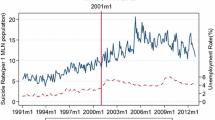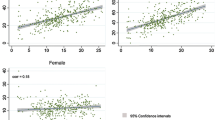Abstract
From the mid-1990s on, the suicide rate in Italy declined steadily, then apparently rose again after the onset of the Great Recession, along with a sharp increase in unemployment. The aim of this study is to test the association between the suicide rate and unemployment (i.e., the unemployment rate for males and females in the period 1977–2015, and the long-term unemployment rate in the period 1983–2012) in Italy, by means of cointegration techniques. The analysis was adjusted for public unemployment spending (referring to the period 1980–2012). The study identified a long-run relationship between the suicide rate and long-term unemployment. On the other hand, an association between suicide and unemployment rate emerged, though statistically weaker. A 1% increase in long-term unemployment increases the suicide rate by 0.83%, with a long-term effect lasting up to 18 years. Public unemployment spending (as percentage of the Italian gross domestic product) may mitigate this association: when its annual growth rate is higher than 0.18%, no impact of unemployment on suicide in detectable. A decrease in the suicide rate is expected for higher amounts of social spending, which may be able to compensate for the reduced level of social integration resulting from unemployment, helping the individual to continue to integrate into society. A corollary of this is that austerity in times of economic recession may exacerbate the impact of the economic downturn on mental health. However, a specific “flexicurity” system (intended as a combination of high employment protection, job satisfaction and labour-market policies) may have a positive impact on health.

Source: Istat [1]

Similar content being viewed by others
Notes
See Stock and Watson [36] for details.
In the Johansen procedure, ECM models are estimated from a vector autoregression representation of the variables (VAR). For this reason in this section we refer to the VAR lag length to test for cointegration. Note that there is a correspondence between the VAR lag structure and the lags in the ECM. For example a VAR(2), i.e., a model with two lags, corresponds to an ECM (1), i.e., with one lag in the variables. AIC: Akaike information criterion; BIC: Schwartz information criterion; HQC:Hannan-Quinn criterion.
The convergence to a particular lag structure depends on the parametrization of the starting model used, hence we use a reduction strategy from a VAR(5) to VAR(2) to choose the final VAR lag length. This reduction strategy is available upon request to the authors. When there is no convergence in indicating the lag length, Table 2 shows the cointegration results for all VAR models suggested by each criterium or combination of criteria.
References
Italian National Institute of Statistics (ISTAT): Giornata mondiale per la prevenzione del suicidio: le statistiche dell’Istat. https://www.istat.it/it/archivio/203366, (2015). Accessed 14 June 2018
Fubini, F.: Recessione Italia. Come usciamo dalla crisi più lunga della storia. Editori Laterza: Rome-Bari (2014) (in Italian)
Durkheim, E.: On Suicide (1897). Richard Sennett (Introduction), Robin Buss (Translator). Penguin Classics, London (2006)
Eisenberg, P., Lazarsfeld, P.F.: The psychological effects of unemployment. Psychol. Bull. 35(6), 358–390 (1938)
Ginsberg, R.: Anomie and Aspirations: A Reinterpretation of Durkheim’s Theory. Arno Press, New York (1967)
Hamermesh, D., Soss, N.: An economic theory of suicide. J. Polit. Econ. 82(1), 83–98 (1974)
Platt, S.: Unemployment and suicidal behaviour: a review of the literature. Soc. Sci. Med. 19(2), 93–115 (1984)
Notzon, F., Komarov, Y., Ermakov, S., Sempos, C., Marks, J., Sempos, E.: Causes of declining life expectancy in Russia. JAMA. 279(10), 793–800 (1998)
Neumayer, E.: Recessions lower (some) mortality rates: evidence from Germany. Soc. Sci. Med. 58(6), 1037–1047 (2004)
Barstad, A.: Explaining changing suicide rates in Norway 1948–2004: the role of social integration. Soc. Indic. Res. 87, 47–64 (2008)
Tapia-Granados, J.A., Diez Roux, A.V.: Life and death during the Great Depression. Proc. Natl. Acad. Sci. USA. 106(41), 17290–17295 (2009)
Stuckler, D., Basu, S., Suhrcke, M., Coutts, A., McKee, M.: The public health effect of economic crises and alternative policy responses in Europe: an empirical analysis. Lancet 374, 315–323 (2009)
Harper, S., Charters, T.J., Strumpf, E.C., Galea, S., Nandi, A.: Economic downturns and suicide mortality in the USA, 1980–2010: observational study. Int. J. Epidemiol. 44(3), 956–966 (2015)
De Vogli, R., Vieno, A., Lenzi, M.: Mortality due to mental and behavioral disorders associated with the Great Recession (2008–2010) in Italy: a time trend analysis. Eur. J. Public. Health 24(3), 419–421 (2014)
Pompili, M., Vichi, M., Innamorati, M., Lester, D., Yang, B., De Leo, D., Girardi, P.: Suicide in Italy during a time of economic recession: some recent data related to age and gender based on a nationwide register study. Health Soc. Care Community 22(4), 361–372 (2014)
Mattei, G., Ferrari, S., Pingani, L., Rigatelli, M.: Short-term effects of the 2008 Great Recession on the health of the Italian population: an ecological study. Soc. Psychiatry Psychiatr. Epidemiol. 49, 851–858 (2014)
Mattei, G., De Vogli, R., Ferrari, S., Pingani, L., Rigatelli, M., Galeazzi, G.M.: Impact of the economic crisis on health-related behaviors in Italy. Int. J. Soc. Psychiatry 63, 649–656 (2017)
Phiri, A., Mukuka, D.: Does unemployment aggravate suicide rates in South Africa? Some empirical evidence. Munich Personal RePEc. Paper no. 80749, posted 11 August 2017 15:45 UTC. Archive Online. https://mpra.ub.uni-muenchen.de/80749/MPRA (2017). Accessed 2 Nov 2018
Fountoulakis, K.N., Koupidis, S.A., Siamouli, M., Grammatikopoulos, I.A., Theodorakis, P.N.: Suicide, recession and unemployment. Lancet 381(9868), 721–722 (2013)
Ostamo, A., Lönnqvist, J.: Attempted suicide rates and trends during a period of severe economic recession in Helsinki, 1989–1997. Soc. Psychiatry Psychiatr. Epidemiol. 36(7), 354–360 (2001)
Nandi, A., Prescott, M.R., Cerda, M., Vlahov, D., Tardiff, K.J., Galea, S.: Economic conditions and suicide rates in New York City. Am. J. Epidemiol. 175(6), 527–535 (2012)
Oskarsson, H., Bjarnadóttir, S.: Suicides and the economic crisis: the Icelandic experience. Eur Psychol 28(S1), 1–2 (2013)
Saurina, C., Bragulat, B., Saez, M., Lopez-Casasnovas, G.: A conditional model for estimating the increase in suicides associated with the 2008–2010 economic recession in England. J. Epidemiol. Community Health 67(9), 779–787 (2013)
Miret, M., Caballero, F.F., Huerta-Ramirez, R., Moneta, M.V., Olaya, B., Chatterji, S., Haro, J.M., Ayuso-Mateos, J.L.: Factors associated with suicidal ideation and attempts in Spain for different age groups. Prevalence before and after the onset of the economic crisis. J. Affect. Disord. 163, 1–9 (2014)
Ceccherini-Nelli, A., Priebe, S.: Economic factors and suicide rates: associations over time in four countries. Soc. Psychiatry Psychiatr. Epidemiol. 46(10), 975–982 (2011)
Martin-Carrasco, M., Evans-Lacko, S., Dom, G., Christodoulou, N.G., Samochowiec, J., González-Fraile, E., Bienkowski, P., Gómez-Beneyto, M., Dos Santos, M.J., Wasserman, D.: EPA guidance on mental health and economic crises in Europe. Eur. Arch. Psychiatry Clin. Neurosci. 266, 89–124 (2016)
Alptekin, D., Alptekin, V., Utsal, D.: A VAR analysis of the unemployment–suicide relationship in the case of Turkey within the context of anomie theory. The Journal of Academic Studies 12(44), 63–83 (2010)
Milner, A., Page, A., LaMontagne, A.D.: Long-term unemployment and suicide: a systematic review and meta-analysis. PLoS One 8(1), e51333 (2013)
McKee-Ryan, F.M., Song, Z., Wanberg, C.R., Kinicki, A.J.: Psychological and physical well-being during unemployment: a meta-analytic study. J. Appl. Psychol. 90, 53–76 (2005)
Stankunas, M., Kaledien, R., Starkuviene, S., Kapustinskiene, V.: Duration of unemployment and depression: a cross-sectional survey in Lithuania. BMC Public Health 6, 174 (2006)
Urbanos-Garrido, R.M., Lopez-Valcarce, B.G.: The influence of the economic crisis on the association between unemployment and health: an empirical analysis for Spain. Eur. J. Health. Econ. 16, 175–184 (2015)
Barnay, T.: Health, work and working conditions: a review of the European economic literature. Eur. J. Health Econ. 17, 693–709 (2016)
Stuckler, D., Basu, S.: The Body Economic. Allen Lane, London (2013)
Organisation for Economic Co-operation and Development: Long-term unemployment rate (indicator). https://doi.org/10.1787/76471ad5-en. Accessed 23 Aug 2018
Organisation for Economic Co-operation and Development: Public unemployment spending (indicator). https://doi.org/10.1787/55557fd4-en. Accessed 23 Aug 2018
Stock, J.H., Watson, M.W.: Introduction to Econometrics, 3rd edn. Pearson Education Limited, Harlow (2015)
Johansen, S.: Statistical analysis of co-integration vectors. J. Econ. Dyn. Control. 12(2–3), 231–254 (1988)
Doornik, J.A.: Approximations to the asymptotic distribution of co-integration tests. J. Econ. Surv. 12, 573–593 (1998)
Rivera, B., Casal, B., Currais, L.: Crisis, suicide and labour productivity losses in Spain. Eur. J. Health Econ. 18, 83–96 (2017)
Korhonen, M., Puhakka, M., Viren, M.: Economic hardship and suicide mortality in Finland, 1875–2010. Eur. J. Health 17, 129–137 (2016) Econ
Orlewska, K., Orlewska, E.: Burden of suicide in Poland in 2012: how could it be measured and how big is it? Eur. J. Health Econ. 19, 409–417 (2018)
Bleuler, E.: Dementia Praecox or the Group of Schizophrenias. International Universities Press, New York (1950[1911])
Bourdieu, P.: The forms of capital. In: Richardson, J. (ed.) Handbook of Theory and Research for the Sociology of Education. Greenwood, New York (1986)
Coleman, J.S.: Social capital in the creation of human capital. Am. J. Soc. 94, S95–S120 (1988)
De Vogli, R.: Progress or Collapse. The Crises of Market Greed. Routledge, Milton Park Abingdon (2013)
Odone, A., Landriscina, T., Amerio, A., Costa, G.: The impact of the current economic crisis on mental health in Italy: evidence from two representative national surveys. Eur J Public Health 28, 490–495 (2018)
Starace, F., Mungai, F., Sarti, E., Addabbo, T.: Self-reported unemployment status and recession: an analysis on the Italian population with and without mental health problems. PLoS One 12, 7–10 (2017)
Mattei, G., Pistoresi, B., De Vogli, R.: Impact of the economic crises on suicide in Italy: the moderating role of active labor market programs. Soc. Psychiatry Psychiatr. Epidemiol. (2018). https://doi.org/10.1007/s00127-018-1625-8
Zhongjun, Q., Perron, P.: A modified information criterion for co-integration tests based on a VAR approximation. Econ Theory 23, 638–685 (2007)
Yang, A.C., Tsai, S.J., Huang, N.E.: Decomposing the association of completed suicide with air pollution, weather, and unemployment data at different time scales. J Affect Disord. 129, 275–281 (2011)
Acknowledgements
The authors wish to thank Prof. William J. Bromwich for the linguistic revision of the manuscript. The authors also thank Marcello D’Amato and Andrea Marchioni for their useful suggestions. Barbara Pistoresi gratefully acknowledges the financial support provided by Fondo per le Agevolazioni alla Ricerca (FAR) 2017 provided by the University of Modena and Reggio Emilia, Italy.
Author information
Authors and Affiliations
Corresponding author
Ethics declarations
Conflict of interest
The authors have no conflict of interest in connection with this study.
Rights and permissions
About this article
Cite this article
Mattei, G., Pistoresi, B. Unemployment and suicide in Italy: evidence of a long-run association mitigated by public unemployment spending. Eur J Health Econ 20, 569–577 (2019). https://doi.org/10.1007/s10198-018-1018-7
Received:
Accepted:
Published:
Issue Date:
DOI: https://doi.org/10.1007/s10198-018-1018-7




